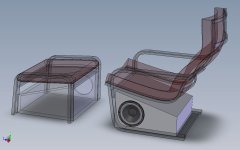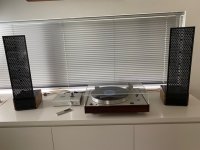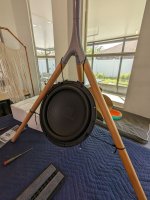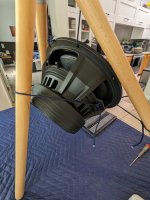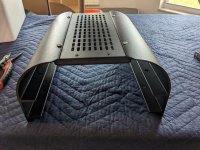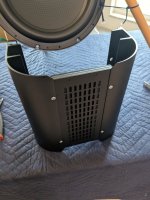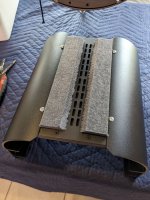Sorry, I had missed your questions. I've looked at those ER panels for quiet a few years, but never got up the courage to buy a kit.Hi studiotech,
is your ScanSpeak RAL cube without the back an option or too heavy/big ?
If I take the idea of open bafle, Full range and ligth, the first idea comming to mind is that ESL kit : FR and ligth and can be close on articulate arm/rod: http://www.eraudio.com.au/505_Mini_Panels/505_mini_panels.html
The idea of near 38 cm OB for the bass is what will give you the spl cancelation for the rest of the house because near you But that rythmix dual 8 should cope well at 250 hz with the ER audio, no ? Or only the 38 at the back of the chair as a 2 + 1 system ?
cheers
And, yes, the open baffle JBL or something similar will do nicely to keep bass from traveling as much through the house as the Rythmiks. Plus, those Rythmik FM8s are rather pricey and I am not going to settle for a single behind me. 2 of them is more than I'd prefer to spend right now. I enjoy the envelopment of good stereo bass.
How about woofers in a box underneath the chair? Looks like you've got that idea already... I once read long ago that woofers with a bandpass response in open air, go flat when pointed directly at the floor, within inches of the surface. That should be pretty enveloping; unsure how much r/l separation you get.
http://www.eraudio.com.au/505_Mini_Panels/Matt_s_505_s/matt_s_505_s.html
Another vote for an ESL hybrid!
Turns out those Sombetzki ESL personal speakers are full range ESL, where I was assuming there was also a woofer in the base units. But the quoted transducer dimensions (30x50cm) are suspiciously close to two ER Audio mini panels, so maybe that's what's in there?
Another vote for an ESL hybrid!
Turns out those Sombetzki ESL personal speakers are full range ESL, where I was assuming there was also a woofer in the base units. But the quoted transducer dimensions (30x50cm) are suspiciously close to two ER Audio mini panels, so maybe that's what's in there?
Attachments
Nice project!
Looking forward to reading your listening g impressions of the Radian LM10n.
Looking forward to reading your listening g impressions of the Radian LM10n.
Andersonix, do you know how far from the panel that you can effectively separate the bias power supply for those ER panels? Or does that cabling need to be as short as possible?
I've dabbled with some of the ideas you have. First off, IMO your decision to use drum hardware is a smart one. Drum HW is designed to be knocked around and beat on to begin with and good quality HW ie from Yamaha is likely some of the best you can buy, as they make alot of it in their motorcycle division, being its chrome plated.
The next thing you have to consider is how well you can locate audio sources at which frequencies. Everyone has a different threshold of this but most usually can't localize under roughly 150 hz depending on the distance and other sensory cues ie. vibration, distance of vibration source.
The perceived flat FR also changes with distance very ubruptly at varying distances and angles to the ears. The pina resonance is also in a different place for any given person. The amount and location of your hair affects diffraction around your head and alters EQ above 2k to roughly 10k or higher. There's also the 8k cochlea standing wave which fluctuates with hydration level and blood pressure.
All this is much more in-situe when listening to very close proximity audio which isn't being directly fed isolated to the ears ie. through headphones. Bass shakers also change the perceived bass balance and you should LP them as early as you can to reduce structure born vibrational distortion contaminating the audible LF.
A cardioid LF source would obviously reduce LF bleed into the room better than any type of exposed enclosure and provide the lowest THD. A TL type absorption scheme would kill the LF back wave most effectively, but its fussy to get the dampening right and likely space prohibitive.
A tight array of smaller long throw LF drivers would function and sound best in the required passband. The LF is probably the biggest challenge of the design. I'd use left and right sources for LF with adjustable summing to get the best quality bass possible with the highest necessary cutoff for better integration with the mids. If it were me, I'd use planar drivers for everything above 300 hz. Purifi cone drivers are likely the best available THD wise with largest possible xmax.
The next thing you have to consider is how well you can locate audio sources at which frequencies. Everyone has a different threshold of this but most usually can't localize under roughly 150 hz depending on the distance and other sensory cues ie. vibration, distance of vibration source.
The perceived flat FR also changes with distance very ubruptly at varying distances and angles to the ears. The pina resonance is also in a different place for any given person. The amount and location of your hair affects diffraction around your head and alters EQ above 2k to roughly 10k or higher. There's also the 8k cochlea standing wave which fluctuates with hydration level and blood pressure.
All this is much more in-situe when listening to very close proximity audio which isn't being directly fed isolated to the ears ie. through headphones. Bass shakers also change the perceived bass balance and you should LP them as early as you can to reduce structure born vibrational distortion contaminating the audible LF.
A cardioid LF source would obviously reduce LF bleed into the room better than any type of exposed enclosure and provide the lowest THD. A TL type absorption scheme would kill the LF back wave most effectively, but its fussy to get the dampening right and likely space prohibitive.
A tight array of smaller long throw LF drivers would function and sound best in the required passband. The LF is probably the biggest challenge of the design. I'd use left and right sources for LF with adjustable summing to get the best quality bass possible with the highest necessary cutoff for better integration with the mids. If it were me, I'd use planar drivers for everything above 300 hz. Purifi cone drivers are likely the best available THD wise with largest possible xmax.
Well, as long as we're considering out to that degree - what about that chair? It's not acoustically transparent, so sound is going to bounce off the back cushion, which I assume exists on either side of the head when seated.The amount and location of your hair affects diffraction around your head
There was - I swear - a picture of Henry Kloss listening; he used a stool. Didnt look all that comfortable either; but I'm sure he was aware that anything around his head except free space is going to change how it sounds.
I know they make office chairs with that webbing back, which looks pretty transparent to me. Unsure if such material could be applied to your chair or one like it, to make it support the body yet let sound go through - as if you really were floating in 0 G's.
No, I have no practice with these. But with the right HV cable you could go farther....Andersonix, do you know how far from the panel that you can effectively separate the bias power supply for those ER panels? Or does that cabling need to be as short as possible?
I received a pair of the new version Radian LT2.2 tweeter and matching waveguides today. That's the end of the good news. The bad news is that the revised tweeter got wider and no longer fits into the recess of the waveguide to sit flush as it did for LT2. It's about a 2mm difference. Radian either dropped the ball on the design revision or they accidentally labeled old style waveguides as those for the 2.2. I've already contacted Radian with the mistake and we'll see what they say. The construction quality is certainly improved on the new version and now matches that of the 8 and 10" drivers. No more rivets and glued joints.
My thinking is that if the waveguide improves top end response without messing with the midrange, I'll use the waveguide to hold the tweeter and provide an easier place to create something to attach it to the LM10n. Kind of like the bridge that BG created for the Neo3/Neo10 combo shown earlier in this thread.




My thinking is that if the waveguide improves top end response without messing with the midrange, I'll use the waveguide to hold the tweeter and provide an easier place to create something to attach it to the LM10n. Kind of like the bridge that BG created for the Neo3/Neo10 combo shown earlier in this thread.
@jjasniew I can't imagine listening to music sitting on a little stool and being so comfortable. To me that defeats the purpose of getting the most from the experience, just from a comfort aspect alone.
I used to place a large diffuser panel behind me to get rid of the immediate reflections causing wonky lower midrange FR. While it sounded much cleaner, it killed the room too much and was too sterile. I settled on some Japanese folding partitions which were a good compromise. I tried a small subwoofer right behind the chair facing forward, which sounded very clean and musical while giving some visceral impact as well. Live music sounded really good with this setup.
I however prefer larger, less directional speakers playing in the midfield. The room enhanced the overall experience more than expected, despite my preference for a well dampened, treated room.
I used to place a large diffuser panel behind me to get rid of the immediate reflections causing wonky lower midrange FR. While it sounded much cleaner, it killed the room too much and was too sterile. I settled on some Japanese folding partitions which were a good compromise. I tried a small subwoofer right behind the chair facing forward, which sounded very clean and musical while giving some visceral impact as well. Live music sounded really good with this setup.
I however prefer larger, less directional speakers playing in the midfield. The room enhanced the overall experience more than expected, despite my preference for a well dampened, treated room.
Didnt mean having to do that as much as perhaps some modification of the present idea to accommodate. Ex, a dentist chair tips back, has lots of unobstructed space about the head (for them to get in there to work); maybe there's a comfortable lie-back arrangement that has no structure around, in the vicinity of, the head. Or if it does, is acoustically transparent.I can't imagine listening to music sitting on a little stool and being so comfortable.
Finally got some more time to mock up options today.
Attachments
Still collecting parts and figuring out mounting solutions. I've bought a whole pile of drum rack hardware to make into some sort of rolling cart that I imagine everything will attach to.
@studiotech
Have you had the chance to listen to the LM10n and tweeter together? How do you like the nidrange vs other drivers you've tried?
Have you had the chance to listen to the LM10n and tweeter together? How do you like the nidrange vs other drivers you've tried?
- Home
- Loudspeakers
- Multi-Way
- Unusual new project in the planning stages
